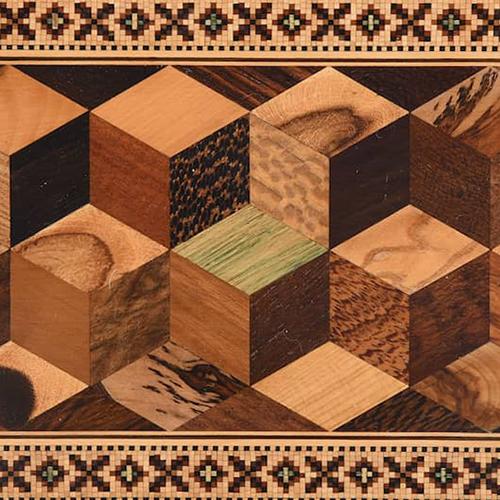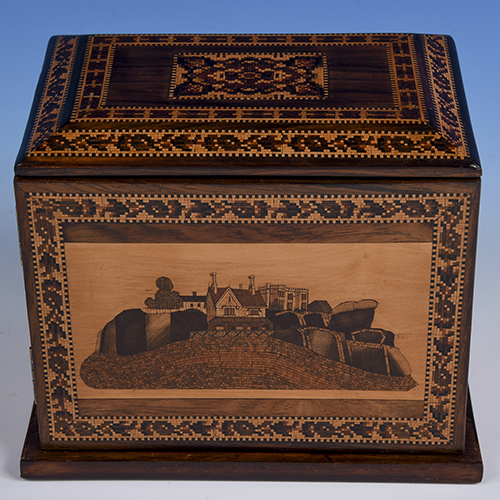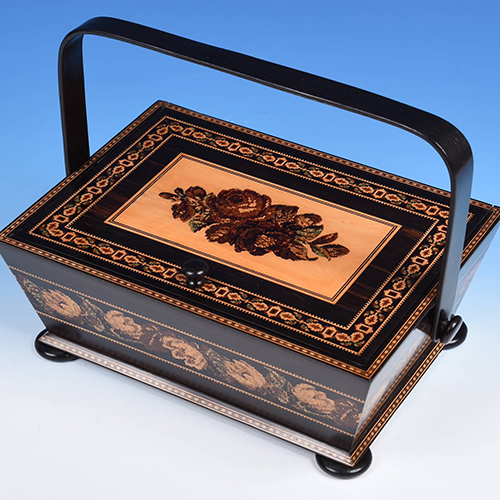

Tunbridge ware is the collective term given to a form of decorative inlaid woodwork in which small pieces of different coloured woods are used to form a mosaic or geometric pattern. As its name suggests, the technique was developed in the historic Kent town of Tunbridge Wells.
The origins of Tunbridge ware are routed in the town’s history as a spa resort. Historically part of the parish of Speldhurst, Tunbridge’s fortunes changed in 1606 when Baron North stayed at a nearby hunting lodge in the hope that the country air would improve his ill health.
Having discovered, and consumed the nearby mineral spring waters, North became convinced that the water had healing properties. He encouraged his friends at court to visit, including Queen Henrietta Maria, wife of King Charles I, and by 1631 a spa resort was established.
Over the next century houses and shops sprang up to cater to the tastes of the wealthy visitors with enterprising local artisans crafting all manner of souvenirs. These early examples of wood craft were referenced by the travel writer Celia Fiennes, who described in her memoir ‘Through England on a Side Saddle’, “shops full of all sorts of toys, silver, china, milliners and all sorts of curious wooden ware”.
Many of these early souvenirs were simply whitewood boxes decorated with printed depictions of local life and landmarks, often produced by Wise's Tunbridge Ware Manufactory, ironically based in nearby Tonbridge. It would be more than a century before the elaborate marquetry style for which the town is so famous became readily available.
 One of the most successful early makers in the area were the Burrows family who began producing wares around the mid-18th century. Arguably the most influential family member was James Burrows who is credited with inventing the stickware, half-square mosaic and tessellated mosaic styles.
One of the most successful early makers in the area were the Burrows family who began producing wares around the mid-18th century. Arguably the most influential family member was James Burrows who is credited with inventing the stickware, half-square mosaic and tessellated mosaic styles.
In stickware, a collection of different woods each cut into cross sections of diamond or triangular shape are glued together to form a pleasing pattern, which in turn was lathe-turned to form a finished item or glued around a mould to create hollow objects such as bowls.
Half square mosaic repeated the process of stickware, but instead of shaping the finished block into an object, the block was then cut into cross sections and used as patterned veneers to be applied to a box or cabinet.
Tessellated mosaic was by far the most complicated, intricate, and desirable of the three and involved using minute tiles to form a pictorial design of geometric pattern. Up to 40 different woods were used to create the various colours and grains. The most interesting being the colour green which was created by taking wood from fallen oak trees infected with the fungus Chlorociboria aeruginascens.
Although predominantly used for the construction of boxes, such as tea caddies, jewellery boxes and needlework boxes, all manner of practical items were produced in the fashion, from inkstands and bookmarks to cribbage boards and clothes brushes.
 Tunbridge ware achieved international recognition in 1851 when no less than three manufacturers displayed their wares at the Great Exhibition in Hyde Park. Notable maker Edmund Nye received a commendation from the judges for a table featuring a tessellated mosaic of a ship at sea, which used more than 110,000 tiles in its construction.
Tunbridge ware achieved international recognition in 1851 when no less than three manufacturers displayed their wares at the Great Exhibition in Hyde Park. Notable maker Edmund Nye received a commendation from the judges for a table featuring a tessellated mosaic of a ship at sea, which used more than 110,000 tiles in its construction.
Sadly, as tastes changed and seaside resorts grew in popularity with Victorian holiday makers, the demand for Tunbridge ware diminished. Although little more than a cottage industry, the town had supported nine workshops at its peak, with another in nearby Tonbridge. The final firm, Boyce, Brown and Kemp closed its doors in 1927.
Tunbridge ware remains a hugely popular and uniquely British craft. Visitors to the area can find an impressive permanent collection of examples at the Tunbridge Wells Museum and Art Gallery. There are also plaques celebrating the lives of Edmund Nye and fellow maker Thomas Barton at their former workshop in the town.
Click here to view a collection of items currently available from BADA members.

